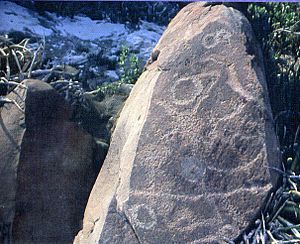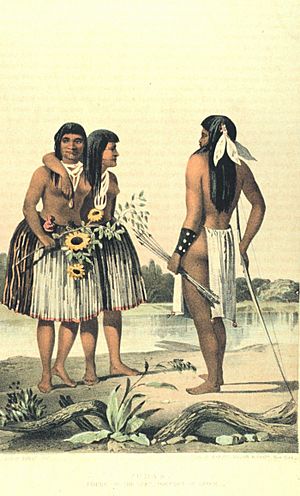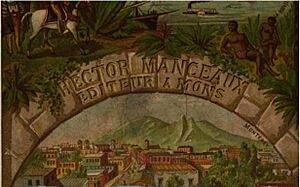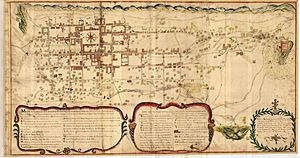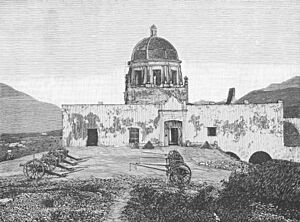History of Monterrey facts for kids
The city of Monterrey in Mexico has a history closely tied to the state of Nuevo León. When the New Kingdom of León was first created, it included Monterrey, Monclova, Saltillo, and Cerralvo. The first families who settled there were often nomadic herders from Portugal. They gradually moved into the area, sometimes clashing with the native groups who already lived there.
Monterrey became a very important place for business and factories because it was close to the border with the United States. For a long time, the city was quite isolated by the Sierra Madre mountains. But by the late 1800s and through the 1900s, many big changes happened in how people lived, worked, and governed.
Contents
Who Were the First People in Monterrey?
The very first people to live in this area were groups known as the Chichimecas. Studies show that their culture is about twelve thousand years old!
The name Chichimecas was used to tell them apart from the larger, more powerful groups in Mesoamerica, like the Mayan, Olmec, and Zapotec. These groups were often nomadic, meaning they moved around regularly within their own territories. They didn't build huge cities like some other groups in central Mexico.
When Spanish settlers arrived, they gave new names to these native groups. Experts have found different languages spoken by the tribes in the region. The groups living where Monterrey is today were called the "Aguaceros" (meaning "heavy rains") and the "Malincheños."
These early people lived in caves and along rivers. They left behind amazing cave paintings and carvings. They also left tools like mortars (for grinding), hollowed stones, and spearheads. Some spearheads found in the Ramones area are over 11,000 years old! Many ancient tools and waste found in the area suggest that a good number of people lived there, at least during certain seasons. Tests show that people were living in Boca de Potrerillos about 8,000 years ago.
From 1960 to 1967, archaeologists from the University of Texas at Austin studied this entire area. You can also visit archaeological museums in the towns of Mina and Linares to learn more.
How Monterrey Was Founded in the 1500s
The First Try: Saint Lucia (1577)
Captain Alberto del Canto, who was born in the Azores in 1547, was asked to create new settlements for New Vizcaya. In 1577, he established towns like Santiago del Saltillo, Minas de la Trinidad (Monclova), and Minas de San Gregorio (Cerralvo). He also marked a spot called Santa Lucia in the Extremadura Valley. This spot is now the center of modern-day Monterrey.
The Second Try: "Villa de San Luis Rey de Francia" (1582)
In 1567, a Portuguese man named Luis de Carvajal y de la Cueva arrived in New Spain. He was put in charge of "pacifying" (or calming down) the Huasteca region. He explored many areas, including a route from Zacatecas to Mazapil in 1573.
The kings of Spain didn't usually pay for these explorations. Instead, they allowed explorers to do it themselves. Carvajal went to Spain and made a deal with King Philip II. He was given permission to settle a huge area, about 1,000 kilometers inland.
In 1580, Carvajal's men arrived in Veracruz. They then traveled to Tampico. Carvajal immediately started his work. On April 12, 1582, he founded the city of Leon (which is now Cerralvo). That same year, in the old Saint Lucia area, Carvajal founded another settlement called Villa de San Luis Rey de Francia. Some records say that up to 200 men were in these places, working to bring more people to the villages.
To manage these large lands, Carvajal appointed three lieutenants in 1585. However, the Viceroy (a high-ranking official) started a legal case against Carvajal, saying he was taking land that wasn't his. Carvajal faced many problems and couldn't continue his work as governor.
While Carvajal was away, his nephew, Luis de Carvajal the Younger, took over. But fighting between the native people and the settlers caused the town of San Luis to become empty. The city of Leon and the town of Cave also faced similar problems. Eventually, Diego de Montemayor, one of Carvajal's lieutenants, decided to leave his territory and moved to Saltillo.
Around 1588, Luis de Carvajal was released from his troubles. He tried to repopulate the mines of Trinidad, renaming them New Almaden (Monclova). He appointed Diego de Montemayor as lieutenant governor of Coahuila, with power over Saint Lucia. But Carvajal's problems continued. He was accused of invading territories and faced religious charges. He was arrested and died in prison.
After these events, the New Kingdom of León was left empty once more.
The Final Founding: Metropolitan City of Our Lady of Monterrey (1596)
It was very hard to establish the New Kingdom of León, as many attempts had failed. Diego de Montemayor, who had been a lieutenant under Carvajal, returned after eight years. On September 20, 1596, he successfully founded the Metropolitan City of Our Lady of Monterrey. This was in the same place where Saint Lucia and the failed Villa of San Luis King of France had been.
Even though Montemayor had left the settlement years before, his claims were still valid. Years later, on February 11, 1599, the Viceroy officially gave Montemayor the title to the region, after consulting with Spain.
Life in Monterrey in the 1600s
Early Years and Challenges
In its early days, the New Kingdom of León was just a name. The first settlers, about 34 people including children, faced many difficulties. They ate wild plants, raised small animals, and farmed. Their houses were made of adobe (mud bricks). Sadly, heavy rains and floods in 1611 destroyed much of what they had built.
After Montemayor died, his son Diego took over but died the next year. The Viceroy then appointed Agustin de Zavala, a wealthy miner, to lead the city. He managed the city through local officials.
After the 1611 floods, people started rebuilding the city in a slightly higher place, which is now Plaza Zaragoza. General Zavala kept a store of flour, seeds, and other supplies for over 10 years to help the families. He also continued efforts to make peace with local native groups and set up a military base.
By 1602, this small kingdom had a convent (a religious community) called San Andrés. After the floods, it moved to a new site in 1626. The church played a big role in trying to "pacify" the native peoples. This often meant trying to get them to work for the settlers. Many missions were set up in the 1600s, like Santa Maria degli Angeli White River (Aramberri) and San Nicolas de Gualeguas (1672).
The Tlaxcalans Arrive
Another important group that helped settle the New Kingdom of León were the Tlaxcalans. They had formed an alliance with the Spanish leader Hernán Cortés earlier. Throughout the 1600s and 1700s, hundreds of Tlaxcalan families moved to northern Mexico. They taught the native groups, when they were peaceful, about farming and handicrafts. The Tlaxcalans who moved north were given special rights, similar to Spaniards, such as owning land and riding horses.
In the 1700s, the town of Guadalupe was established next to Monterrey. It was settled by Tlaxcalan families who had already been living in other towns.
Powerful Landowners
Just like in other parts of New Spain, the New Kingdom of León had different social groups: gentlemen, soldiers, miners, and others. Governors and lieutenants were important, but so were the families who first founded the settlements. Their power grew if they had lots of resources or "mercedes"—large areas of land, native workers, cattle, and servants given by the King.
In the 1600s, Bernabé de las Casas was a very important person. He owned a huge estate that stretched from northeast Monterrey all the way to what is now Colima. When his land was divided among his children, it created new haciendas (large farms) that later became towns like Mina, Hidalgo, El Carmen, and Abasolo.
During the colonial period, Monterrey was often focused on struggles over land and power. Many people in the city were soldiers, serving the King. They would gather in the main square, called Plaza de Armas, before going to battle.
Monterrey in the 1700s
Religious Buildings
The second bishop, Rafael José Verger, wanted the main church office to be in Monterrey. He built his home, which is now the bishopric building, on Loma de la Chepevera. He also wanted the cathedral to be in that area. Finally, in 1789, the king ordered the church council to be based in Monterrey. On November 10, 1792, a bishopric was officially set up in Monterrey under Bishop Andrés Ambrosio de Llanos and Valdés. An architect was brought in to plan a new cathedral and expand the city, but the project was not finished due to opposition from the governor.
Monterrey in the 1800s
Mexican Independence
When news reached Monterrey that Miguel Hidalgo had started a fight against Spanish rule, the governor of Nuevo León, Santa Maria, sent a commander named Juan Ignacio Ramón to stop the rebels. But instead, Ramón quickly joined the rebel group! Santa Maria also ended up supporting the independence movement.
From Saltillo, the rebel leader Jimenez sent others to Monterrey to take control. On January 26, 1811, they arrived in Monterrey and were welcomed with joy. They appointed Jose Santiago Villareal as governor. Even after Hidalgo's defeat, rebel fighting continued in the area. On July 3, 1821, Gaspar López, the governor of Nuevo León, announced that Monterrey supported Mexico's independence.
The Battle of Monterrey
After Mexico became independent from Spain in 1821, Mexico and the United States fought the Mexican-American War. This war caused Mexico to lose more than half of its land. On September 23, 1846, General William J. Worth's army surrounded Monterrey. A big battle took place from Cerro del Obispado to Villa de Guadalupe, known as the Battle of Monterrey. American troops stayed in Mexico until 1848. The war ended with the treaty of Guadalupe Hidalgo. In this treaty, the United States gained the territories of Alta California and New Mexico, as well as the land between the Nueces River and the Rio Grande.
The Porfiriato Era
Bernardo Reyes
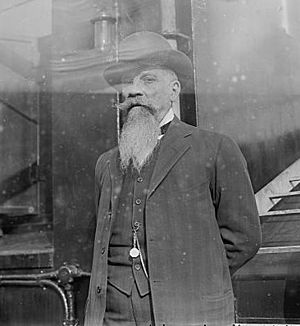
This period refers to the long time when Porfirio Díaz was president of Mexico.
Monterrey in the 1900s
The Mexican Revolution
Many people in Mexico were unhappy with Porfirio Díaz's long and strict rule in the early 1900s. Around 1900, Bernardo Reyes, a popular figure from Monterrey, went to Mexico City. While he was away, groups against the government became more active in Monterrey, especially law students. In 1902, Reyes returned to Monterrey as governor and, with Díaz's support, started campaigning for re-election. The opposition groups grew stronger. They published articles and statements asking for individual rights and fair elections, and speaking out against the dictatorship.
On April 2, 1903, a day celebrating Porfirio Díaz, Reyes's supporters gathered in Zaragoza square. At the same time, opposition supporters gathered in another area. A clash between the two groups turned violent. Eight people died, 70 were wounded, and about a hundred opposition supporters were put in jail.
After this, Reyes took power for the fourth time. He became very popular across the country, and many saw him as a possible replacement for Díaz. However, Díaz decided to run for president again, with Ramón Corral as his vice president. Reyes's popularity was seen as a threat to Díaz's plans. Díaz eventually sent Reyes to Europe on a military mission, removing him from the political scene.
A terrible natural disaster hit Monterrey before the Mexican Revolution fully began. On August 28, 1909, the Santa Catarina River overflowed. This caused the worst flood in the city's history, with thousands of victims and huge damage.
The country was very unstable in the early 1900s. Battles became more intense after President Francisco I. Madero was killed. Many people were unhappy with the government of Victoriano Huerta. Venustiano Carranza started a revolution in 1913 to overthrow Huerta's government.
On October 23, 1913, Carranza's forces, led by General Pablo González, arrived in Monterrey. They took over important buildings like the bishopric and military barracks. Other revolutionaries went to the Alameda park and took over the prison. Even though the federal forces were strongly defended, the revolutionaries managed to capture the Villa de Guadalupe. That same day, the rebel forces reached Mina Street and the Gulf Station, setting up their headquarters there.
Constitutional Government
The Mexican Revolution led to the Constitution of 1917. In Monterrey and across the state, the revolution also led to more banditry, which the first constitutional government had to control. After the revolution, there was also an outbreak of Spanish influenza. In Monterrey alone, this sickness killed 717 people.
City Growth and Culture
The state government created organizations like Fornerrey and Provileon to help people with housing problems. In the 1960s, the city started building taller buildings, like the Acero Condominiums and Constitucion Apartments.
The city's metropolitan area grew, expanding into nearby municipalities like Guadalupe, Garza García, Santa Catarina, San Nicolás, General Escobedo, and Apodaca.
In the 1930s, Monterrey began to develop culturally. In 1933, the Autonomous University of Nuevo León (UANL) was founded. Ten years later, the Monterrey Institute of Technology and Higher Education (ITESM) was established. Soon after, the University City and the Tec Campus were built.
The Macroplaza

The Macroplaza is a huge public square in Monterrey. Many important buildings were built around it, including the Legislative Palace, the City Theater, the Department of Education and Culture, and the Central Library.
The Macroplaza also features many beautiful artworks. These include "The Fountain of Life," sculptures of heroes like "Escobedo," "Hidalgo," and "Morelos" by Luis Sanguino, the Faro de Comercio (Lighthouse of Commerce) by Luis Barragan, and "Homage to the Sun" by Rufino Tamayo. There are also sculptures by Fidias Elizondo, Federico Cantú, and other artists. In the Esplanade of the Heroes, which is part of the Macroplaza, the remains of some of Nuevo León's past governors are kept, including Juan Zuazua and Bernardo Reyes.
|
See also
 In Spanish: Historia de Monterrey para niños
In Spanish: Historia de Monterrey para niños
- Timeline of Monterrey, Mexico


